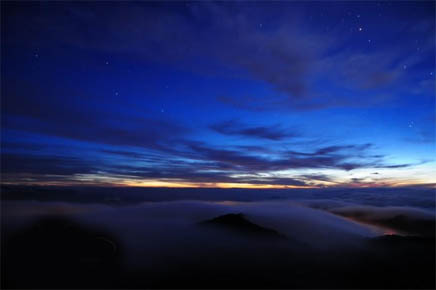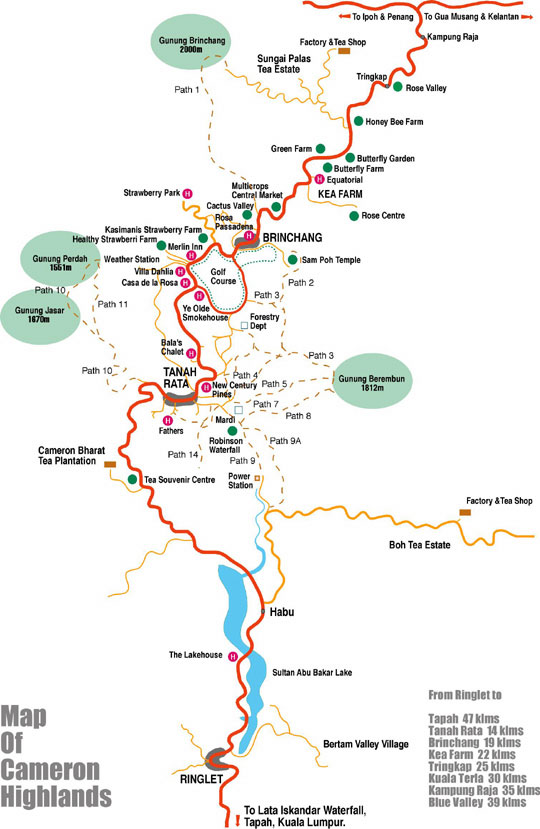

Copyright 2009-2011 by CameronHighlandsInfo.com. All Rights reserved. E-Mail: webmaster@cameronhighlandsinfo.com



Search Any Information About Cameron Highlands Now!

Sunrise Spectacular Cameron Highlands

- Home
- Travel Guide
- Accommodation
- Attractions
- Travel & Tour
- Entertaiment
- Food Guide
- Shopping
- Contact Us
Sunrise is the instant at which the upper edge of the Sun appears above the horizon in the east. Sunrise should not be confused with dawn, which is the (variously defined) point at which the sky begins to lighten, some time before the sun itself appears, ending twilight. Because atmospheric refraction causes the sun to be seen while it is still below the horizon, both sunrise and sunset are, from one point of view, optical illusions. The sun also exhibits an optical illusion at sunrise similar to the moon illusion.
Sunrise and sunset are calculated from the leading and trailing edges of the Sun, and not the center; this slightly increases the duration of "day" relative to "night". The sunrise equation, however, is based on the center of the sun.
The timing of sunrise varies with the time of year and the latitude of the location from which it is viewed. The precise local time of sunrise also depends upon each location's precise longitude within a given time zone. Small daily changes and noticeable semi-annual changes in timing of sunrise are driven by the axial tilt of Earth and the planet's movement in its annual orbit around the sun. Some apparent anomalies exist however.
Sunrise and sunset are calculated from the leading and trailing edges of the Sun, and not the center; this slightly increases the duration of "day" relative to "night". The sunrise equation, however, is based on the center of the sun.
The timing of sunrise varies with the time of year and the latitude of the location from which it is viewed. The precise local time of sunrise also depends upon each location's precise longitude within a given time zone. Small daily changes and noticeable semi-annual changes in timing of sunrise are driven by the axial tilt of Earth and the planet's movement in its annual orbit around the sun. Some apparent anomalies exist however.
The sunrise at Gunung Brinchang ,the highest peak of Cameron Highland. The height is 2032 metres. The radiance of the rising sun is glorious.


Location Gunung Brinchang Map
Due to Earth's axial tilt, whenever and wherever sunrise occurs, it is always in the northeast quadrant from the March equinox to the September equinox and in the southeast quadrant from the September equinox to the March equinox. Sunrises occur precisely due east on the March and September equinoxes for all viewers on Earth. The sunrise and sunset times for a 12 hr day and 12 hr night do not fall on the "equinox" (equal night), since the timing of sunrises and sunsets, and hence, the lengths of day and night vary with each viewer's particular latitude.




The intense red and orange hues of the sky at sunrise and sunset are mainly caused by scattering of sunlight by dust particles, soot particles, other solid aerosols, and liquid aerosols in the earth's atmosphere. These enhanced red and orange colors at sunrise and sunset are mathematically explained by the Mie theory or the discrete dipole approximation. When there are no particulates in the troposphere, such as after a big rain storm, then the remaining less intense reds are explained by Rayleigh Scattering of sunlight by air molecules. Sunrise colors are typically less brilliant and less intense than sunset colors, since there are generally fewer particles and aerosols in the morning air than in the evening air. Nighttime air is usually cooler and less windy, which allows dust and soot particles to settle out of the atmosphere, reducing the amount of Mie Scattering. The reduced Mie Scattering correspondingly reduces the amount of red and orange scattered light at sunrise. Sunrise color intensities can however exceed sunset's intensities when there are nighttime fires, volcanic eruptions or emissions, or dust storms to the east of the viewer.
Sometimes just before sunrise or after sunset a green flash can be seen.
Sometimes just before sunrise or after sunset a green flash can be seen.
